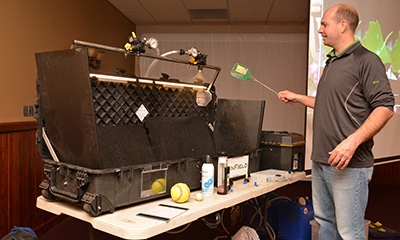
Eradicating weeds is so much broader than choosing the right herbicide. Even with the right product, if it isn’t applied with the right spray technology and according to label, it can’t do an effective job. And with today’s declining commodity prices, every last drop of input must count.
Mark Glady, a Winfield agronomist based in Montevideo, shares information with farmers about best practices to help keep active ingredients on target and at concentrations where they offer the most benefit. Here are Glady’s top five tips:

Comparing nozzles. Agronomist Mark Glady uses a demonstration spray table to show differences in droplet sizes from various nozzles and pressures.
1. Have a consistent spray technique
Keep these four words in mind—onto, into, through and do. Make sure the herbicide gets onto the weed, that there is adequate contact. Once on, the herbicide needs to go into the plant, to be absorbed in sufficient quantity. The herbicide also needs to move through and within the weed to its site of action. And the herbicide must do its job—reach the toxic level necessary at the site of action to kill the weed.
2. Match the nozzle to the chemical for the job
Each herbicide label gives suggested nozzle droplet sizes based on company research. Heed those suggestions. Glady says farmers may need nozzles that produce large droplets later in the growing season to minimize drift.
3. Stay ahead of weed seed germination
Lambsquarter and giant ragweed are some of the first weeds in the spring to germinate. Waterhemp seeds germinate much later in the spring and all season long. Each plant is capable of producing 350,000 seeds.
“Just a couple of plants on one acre in one year can spread to cover an 80-acre field in three years,” he said. “I’ve seen it happen. A few weeds near a tile intake in a field one year exploded to cover an 80-acre field three years later.”
Glady advised removing waterhemp plants from fields before flowers turn to dark purple seed.
In soybean fields with waterhemp pressure this growing season, he recommended an application of a residual herbicide at planting, followed by a second residual along with an early post with PPO inhibitor on weeds less than four inches high about a month after planting.
4. Add adjuvants
An adjuvant adds about $1.50 per acre to crop production costs. However, they deserve to be included in tank mixes in the Upper Midwest. Why? Because we have good ol’ hard water. Hard water contains calcium, which likes to bond with elements in glyphosate, thus deactivating it, Glady said. He suggested adding an adjuvant, such as ammonium sulfate, to the water in the tank first and ideally letting it sit for 15 minutes to allow the AMS to condition the water. Then add glyphosate.
5. Know your nozzles.
Sprayer droplets often range from 100 to 600 microns and various sizes have their advantages and disadvantages. For example, 100 micron droplets provide excellent coverage and have low droplet bounce/shatter. However, they also evaporate very quickly, have very high drift potential and provide poor canopy penetration. On the other side of the spectrum, 600-micron sized droplets offer very low drift potential and good canopy penetration and longer drying times. However, these larger droplets can bounce and shatter and have reduced efficacy for many pesticides.
“The sweet spot for droplet sizes are between 200 to 400 microns,” he said. “Less than 200, they will travel. If you apply them from a height of more than 25 inches, they hang as fog behind the sprayer.” That’s not good because that cloud could drift, too.
“You could be getting half the rate in one spot and double in another, and have loss to evaporation,” he added.
Whatever nozzle you use, Glady said, make sure you know what it can do.
About the Author(s)
You May Also Like






